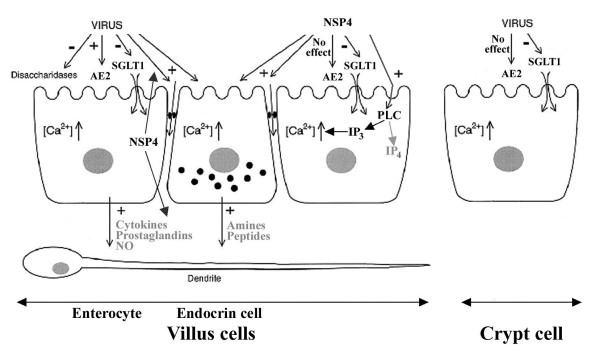Figure 1.
Reality and hypothesis of the pathophysiological mechanisms of rotavirus and NSP4-mediated diarrhea. Rotavirus impairs activities of intestinal disaccharidases and Na+-solute symports coupled with water transport, contributing to massive loss of water into the intestinal lumen. NSP4 specifically inhibits SGLT1-mediated Na+-D-glucose symport activity. Rotavirus and/or NSP4 increases epithelial paracellular permeability, but the importance of this effect on fluid and electrolyte fluxes is difficult to evaluate. Loss of Cl- into the intestinal lumen is established by Cl-/H+ symport activity (AE2) causing Cl-reabsorption or Cl- secretion in villi (depending on the direction of the chloride electrochemical gradient resulting from rotavirus infection), but failing to stimulate Cl-transport in crypt. NSP4 has no direct, specific effect on either intestinal absorption or secretion of chloride. Net chloride secretion is regulated by a phospholipase C (PLC)-dependent calcium signaling pathway induced by NSP4. NSP4 is also secreted at the basal side of enterocytes, but its role in rotavirus disease remains to be defined. It has been proposed that NSP4 may exert both secretory and subsequent anti-secretory actions via IP3 and IP4 respectively, as did carbachol, hence limiting Cl- secretion. It has also been proposed that Ca2+ mobilization may trigger the release of different mediators (cytokines, amines...) which activate the nervous system in the intestinal wall, thereby stimulating Cl- secretion. The signs - and + indicate inhibition and activation, respectively. Further details in the text.

